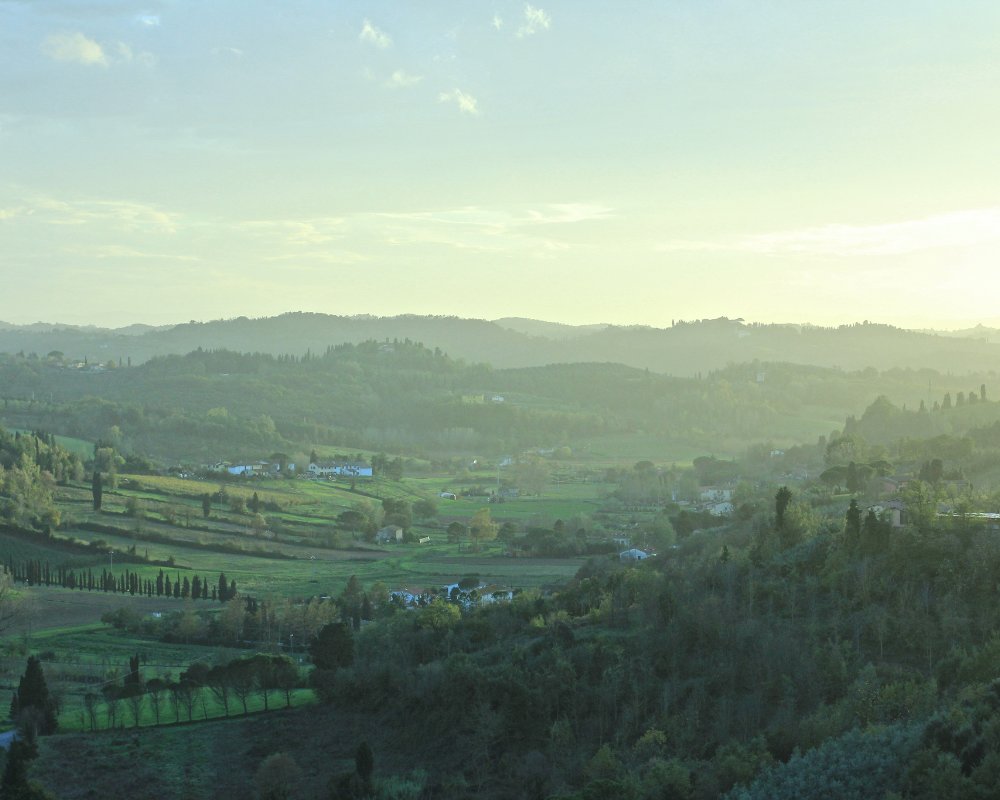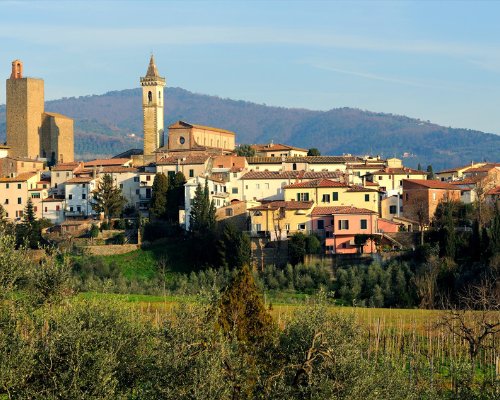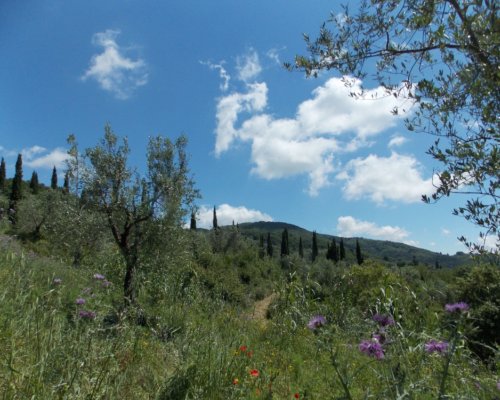Itinerary through breathtaking landscapes
This panoramic itinerary is about 50 km long and passes through the municipalities of Capraia and Limite, Cerreto Guidi, Empoli, Fucecchio, Montelupo Fiorentino and Vinci, all of which lie within the boundaries of the Province of Florence. The itinerary, which can be done by car, motorbike or bicycle, runs from the Terre del Rinascimento to the slopes of Montalbano and the countryside of the Valdelsa, and offers splendid views of vineyards and olive groves, ancient villages and historic villas.
Starting from the San Miniato exit on the superstrada, head in the direction of Fucecchio, which lies on the Via Francigena, an ancient pilgrimage route. It is also near the Padule di Fucecchio, the largest non-coastal marshland area in Italy. In the old town centre it is worth visiting the Corsini complex, which was once the Castello di Salamarzana and then the Fortezza dei Fiorentini. Palazzo Corsini now houses the Fucecchio Museum. One of the town’s famous citizens was the Italian writer and journalist Indro Montanelli, whose memory is preserved at the Fondazione Montanelli Bassi.
From Fucecchio take the SR 436 (follow signs for Montecatini Terme) in the direction of Cerreto Guidi. After passing through the tiny village of Le Botteghe, go right along the road that passes through Poggio Tempesti and has beautiful views of vine-clad hills. Cerreto Guidi, with its imposing Medici villa complex (which also houses the Museum of Hunting and Local History), stands out from a distance. A possible diversion before arriving in Cerreto Guidi is to make for the Fucecchio Marshes, a nature reserve offering a rare refuge for numerous plant and animal species: continue along SP 436 to Castelmartini, where there is one of the entrances to the marshes. The Fucecchio Marshes Research, Documentation and Promotion Centre is also based there.
From Cerreto Guidi, head in the direction of Vinci along SP 105, which runs through the village of Toiano and takes in another characteristic portion of Tuscan countryside. In Vinci, the town where Leonardo was born, the great artist is recalled everywhere: in his birthplace as well as the museums and the monuments dedicated to him. Be sure to visit the Museo Leonardiano and the Casa Natale di Leonardo, which is 3 km away in Anchiano but can be reached along a footpath named the ‘Strada Verde’.
Starting from the San Miniato exit on the superstrada, head in the direction of Fucecchio, which lies on the Via Francigena, an ancient pilgrimage route. It is also near the Padule di Fucecchio, the largest non-coastal marshland area in Italy. In the old town centre it is worth visiting the Corsini complex, which was once the Castello di Salamarzana and then the Fortezza dei Fiorentini. Palazzo Corsini now houses the Fucecchio Museum. One of the town’s famous citizens was the Italian writer and journalist Indro Montanelli, whose memory is preserved at the Fondazione Montanelli Bassi.
From Fucecchio take the SR 436 (follow signs for Montecatini Terme) in the direction of Cerreto Guidi. After passing through the tiny village of Le Botteghe, go right along the road that passes through Poggio Tempesti and has beautiful views of vine-clad hills. Cerreto Guidi, with its imposing Medici villa complex (which also houses the Museum of Hunting and Local History), stands out from a distance. A possible diversion before arriving in Cerreto Guidi is to make for the Fucecchio Marshes, a nature reserve offering a rare refuge for numerous plant and animal species: continue along SP 436 to Castelmartini, where there is one of the entrances to the marshes. The Fucecchio Marshes Research, Documentation and Promotion Centre is also based there.
From Cerreto Guidi, head in the direction of Vinci along SP 105, which runs through the village of Toiano and takes in another characteristic portion of Tuscan countryside. In Vinci, the town where Leonardo was born, the great artist is recalled everywhere: in his birthplace as well as the museums and the monuments dedicated to him. Be sure to visit the Museo Leonardiano and the Casa Natale di Leonardo, which is 3 km away in Anchiano but can be reached along a footpath named the ‘Strada Verde’.
From Vinci, take the road running along the hillside to Vitolini, which affords an excellent view of Vinci to the rear. From Vitolini, the road climbs in the direction of Montalbano (the SP 43 in the direction of Carmignano). The Montalbano hills, which act as a watershed between the Pistoia and Florence plain and the Valdinievole, reach a height of 600 m and are composed of a varied landscape ranging from olive terraces to chestnut woods on the summits. There's a wealth of marked trails that can be done on foot, mountain bike or on horseback. Continuing along the SP 43, after passing the village of Pietramarina, follow signs for Castra.
From Vinci, take the road running along the hillside to Vitolini, which affords an excellent view of Vinci to the rear. From Vitolini, the road climbs in the direction of Montalbano (the SP 43 in the direction of Carmignano). The Montalbano hills, which act as a watershed between the Pistoia and Florence plain and the Valdinievole, reach a height of 600 m and are composed of a varied landscape ranging from olive terraces to chestnut woods on the summits. There's a wealth of marked trails that can be done on foot, mountain bike or on horseback. Continuing along the SP 43, after passing the village of Pietramarina, follow signs for Castra.
In Capraia, which clings to a spur that falls sharply down to the Arno, it is possible to visit the Fornace Pasquinucci, an old kiln formerly used for firing terracotta and now an exhibition centre. On the left bank of the Arno, opposite Capraia, lies Montelupo Fiorentino, an important ceramics manufacturing town whose heyday was in the 15th and 16th centuries. The Museum of Ceramics traces the historic development of the local ceramics industry.
The Montespertoli road from Montelupo Fiorentino leads to Botinaccio, and offers fine views of the beautiful Tuscan countryside, with the harmonic forms of the hills. After this, the route does a circuit towards the Valdelsa countryside and back into the heart of the Terre del Rinascimento. Take the road for Empoli at Coeliaula.
The historic town centre of Empoli is grouped around Piazza Farinata degli Uberti o dei Leoni, onto which the principal historic buildings face: palazzo Pretorio and palazzo Ghibellino, the Collegiata di Sant’Andrea, the Church of Santo Stefano and the adjoining Chiostro degli Agostiniani. Absolutely not to be missed is the Museo della Collegiata and the tiny village of Pontorme, the birthplace of Jacopo Carrucci, otherwise known as Pontormo. Here it is possible to visit the house where the artist was born (now a museum) and the Church of San Michele, which houses two panel paintings, Saint John the Evangelist and Saint Michael Archangel.
In Capraia, which clings to a spur that falls sharply down to the Arno, it is possible to visit the Fornace Pasquinucci, an old kiln formerly used for firing terracotta and now an exhibition centre. On the left bank of the Arno, opposite Capraia, lies Montelupo Fiorentino, an important ceramics manufacturing town whose heyday was in the 15th and 16th centuries. The Museum of Ceramics traces the historic development of the local ceramics industry.
The Montespertoli road from Montelupo Fiorentino leads to Botinaccio, and offers fine views of the beautiful Tuscan countryside, with the harmonic forms of the hills. After this, the route does a circuit towards the Valdelsa countryside and back into the heart of the Terre del Rinascimento. Take the road for Empoli at Coeliaula.
The historic town centre of Empoli is grouped around Piazza Farinata degli Uberti o dei Leoni, onto which the principal historic buildings face: palazzo Pretorio and palazzo Ghibellino, the Collegiata di Sant’Andrea, the Church of Santo Stefano and the adjoining Chiostro degli Agostiniani. Absolutely not to be missed is the Museo della Collegiata and the tiny village of Pontorme, the birthplace of Jacopo Carrucci, otherwise known as Pontormo. Here it is possible to visit the house where the artist was born (now a museum) and the Church of San Michele, which houses two panel paintings, Saint John the Evangelist and Saint Michael Archangel.


